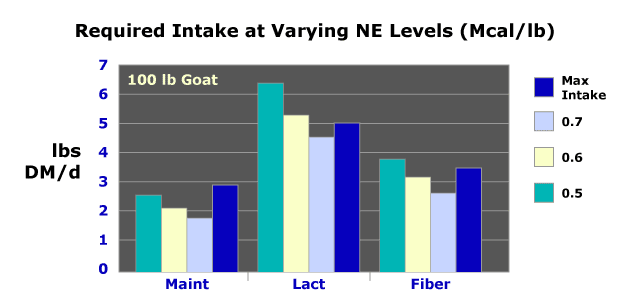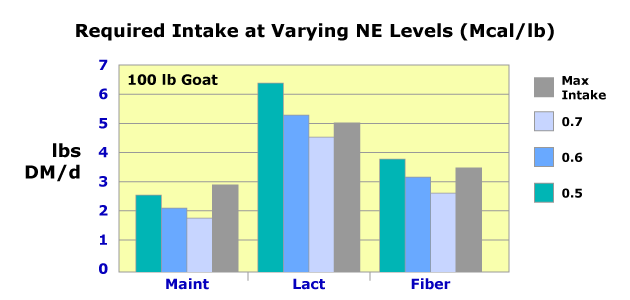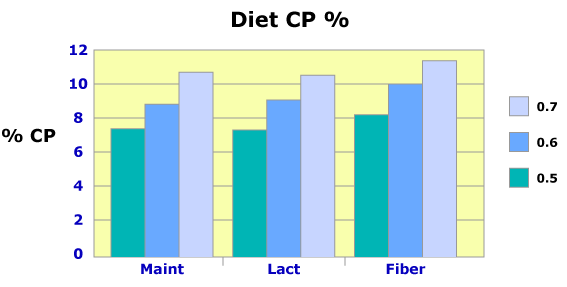Previous Page | Right click this page to print.
Feeding Management and Intake
Usually, goats are on range or at least they’re free-ranging. It can depend upon what you are offering them or pasture. In confinement, they consume similar feedstuffs as other ruminants. So legume hays, legume grasses. Which of the goats...meat, mohair or dairy do you think would be supplemented with high energy feeds? Where would you get your most return at? So, you’re growing goats for meat, mohair and milk which is going to be used for cheese or whatever. Where is the best bang for your buck in supplementation, do you think? It would be to the dairy goats. They would consume high energy feeds similar to what cows would consume, corn and barley in our area. Most of the goats are in the south west so sorghum can be a significant portion of their diet or at least a high energy feedstuff that they’re supplemented with. What about processing? We’ve talked about what animal in this class that you would not be concerned about processing corn for and that is what animal? Sheep. So goats, the corn needs to be cracked, ground. It needs to be processed in some manner. Protein feeds, similar to other ruminant and non-ruminant feeds, soybean meal, cottonseed meal and urea. Same for dairy cows and beef cows.
These are some selected feedstuffs that I have pulled out of a table that would be fed to goats.
NE (Mcal/lb) |
CP (%) |
|
|---|---|---|
Bermuda Hay |
0.46 |
15 |
Ryegrass |
0.51 |
9 |
Alfalfa |
0.51 |
18 |
Corn |
0.74 |
9 |
Sorghum |
0.74 |
10 |
SBM |
0.74 |
46 |
CSM |
0.64 |
41 |
What is the difference between feedstuffs that are at the top of the tables and feedstuffs that get sorted out to the bottom of the table? Tops are forages, the bottoms are concentrates. What about the differences in nutritive value? Concentrates are normally higher in energy. If you notice that corn, sorghum, soybean meal gets sorted to the bottom. In general, they’re also higher in protein.
A few slides on intake, this is the required level of intake at three
different energy concentrations.

So a diet that contains .5 megacals of NEL which is the green, .6 is yellow and .7 is the light blue or gray. What happens to intake regardless if the animal is at maintenance, lactation or producing fiber as energy concentration of the diet increases? It goes down. As energy concentration increases, they don’t need to consume as much to meet the requirement. As a percentage decline in intake, is it more for maintenance, lactation or fiber or is it proportional? As a percent decline is it proportional for maintenance, lactation and fiber production? It is proportional. For maintenance, they need to consume about two pounds of dry matter a day. What about lactating? If you just take the average diet, the yellow line, a little over 5%. We go back to this doe, lactating doe that weighs 100 pounds. Her intake as a percent of body weight would be what? So, 5 divided by 100 is 5%. So some of you said 5.2, so 5 to 5½% intake as a percent of body weight. And then fiber, maybe about three pounds of intake per day. This is not range, this is the maximum voluntary intake as a percent of body weight for different ages at different productive states. Disregard kids for the moment. Look at the dry doe about 2.8% close to 3%. A doe in early pregnancy again about 3%. Late pregnancy, what happens? This also happens in sheep, dairy cows, most species that are in late gestation. What happens to intake in late gestation? So, it decreases, for what reason? You guys know? This is a trick question, because no one knows. A lot of people think it’s because of fill. The fetus has taken up more space, so this displaces rumen capacity and so animals decrease in intake or it takes up abomasum capacity and so they decrease in intake. At least with dairy cows, this has shown to be false. The fetus actually does not displace ruminal capacity, so cows don’t decrease because the fetus is getting larger. As animals move into lactation, intake goes up. So a doe producing a low volume of milk about 4%, a high volume of milk about 5%.
We got the same three bars; we have introduced one new one, which is the
gray. This comes off of the previous table; this is the maximum voluntary
intake.
Maximum Voluntary
Intake, % of BW |
|
|---|---|
Kids |
4.5 |
Dry Doe |
2.8 |
Pregnant Doe, early |
3.0 |
Pregnant Doe, late |
2.7 |
Lactating Doe,
low |
4.0 |
Lactating Doe,
high |
5.0 |

So for a doe at maintenance you could feed her what kind of diet? This is her maximum voluntary intake, you could feed her what kind of diet? The diet with the lowest energy concentration, so the poorest quality diet. What about the doe that’s lactating? Somewhere between the medium to the highest quality diet. And the animal that is producing fiber, or mohair, the medium quality diet.
So, if we bring the intakes from the last slide over and figure out what percent of the diet should be crude protein based upon intakes.

The animals at maintenance would consume somewhere between 8% to 10% of the dry matter as protein. Lactating about the same. Fiber is a bit higher, why is fiber higher? It takes protein to produce mohair, so the same can be said for wool. Somewhere around 10%, 8% to 10%, protein in the diet of a goat would be adequate. Look at goats on range. Think about, when we were talking about beef cows on range, so it would be similar. What was the first limiting nutrient generally for beef cows on range? Crude protein. So it’s very similar for goats. Crude protein is usually first limiting and this can be supplemented with about a quarter to a half a pound of soybean meal per day. For dairy goats, they go through the same negative energy balance as dairy cows in early lactation. It would be important to have proper body condition on the does when they kid. Same as a cow, they'll use fat off their back for energy and milk. Ketosis can be common in dairy goats. It's also common in dairy cows. It's also common in another species that we talked about in this class. It actually does not occur in lactation, it can occur before parturition. What species was that? Sheep. So, ketosis can be common in sheep in late gestation. About six weeks before kidding, to prevent ketosis, you can add about a third of a pound of grain per day and increase it to about a pound per doe per day by kidding or parturition. Flushing can also be used to increase ovulation rate in sheep. Anything that multiple ovulates, so sheep, pigs and what else, what are we talking about today, goats. We can use the same thing in goats. We can increase energy density of the diet before breeding and increase ovulation. For dairy goats, grain feeding will reach a maximum at about three weeks after kidding. So they will be consuming about two or three pounds of grain a day. Their peak lactation, where they produce the most milk, at about month three to four of lactation. Very similar to that of a dairy cow. The concentrate mixture for does, dairy does, consuming a grass forage would be about a 16% to 20% crude protein. For those consuming a legume forage about 12 to 14%. Why is that the crude protein in your concentrate decrease as you move from a grass to legume forage? What is the major difference between, or the major difference in crude protein between grass and legumes? In general legumes always have a higher crude protein concentration than grasses. For Angora goats or fiber goats, flushing is even more important, what was there kidding rate for a fiber goat? It was 100%. Flushing is even more important in these goats because their reproductive rate is so low. You do get a good return if you add additional energy three weeks prior to breeding and three weeks after breeding.
Previous Page | Right click this page to print.